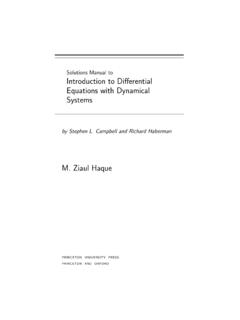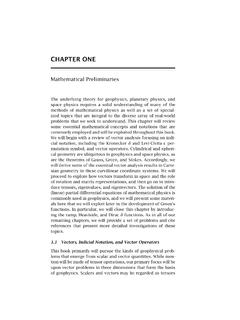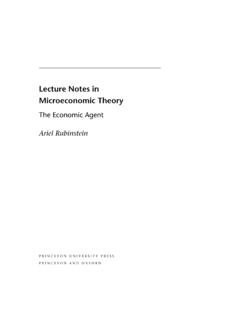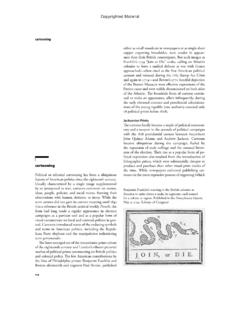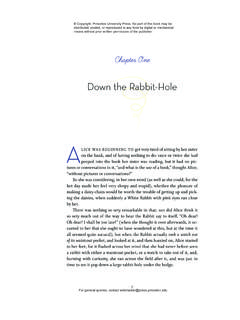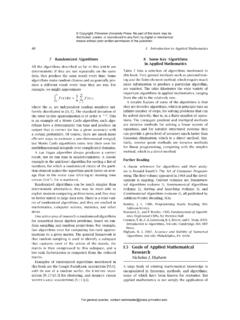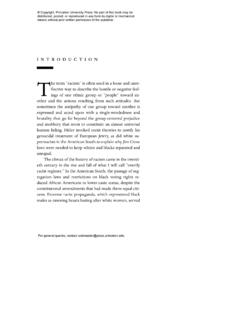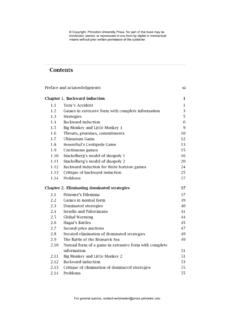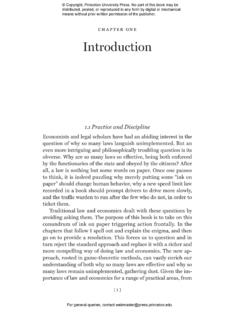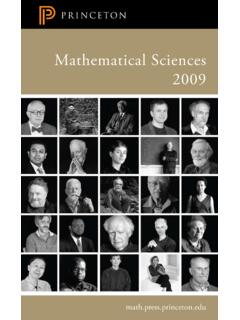Transcription of Effective Population Size - Princeton University
1 Copyrighted Material 12 Conservation of Small Populations: Effective Population Sizes, Inbreeding, and the 50/500 Rule Luke J. Harmon and Stanton Braude Introduction and Background Population size is extremely important in evaluating conservation priorities for a species. Small populations are at risk of going extinct because of demographic stochasticity and genetic drift. In this exercise, you will learn about three of the meanings of Effective popu- lation size and how to estimate two of them. You will then learn how to apply these tech- niques to specific conservation situations, using the concepts of inbreeding, the minimum viable Population size, and the 50/500 rule. Effective Population Size Population size has a major impact on the dynamics of a Population . For example, in chap- ter 11 you used simulations to see that genetic drift reduces allelic diversity much faster in small populations of woggles than in large ones.
2 Population size also influences the chances of extinction through demographic stochasticity, the random change in Population size over time due to random variation in individual survival and reproductive success. Such events have a proportionally large effect in small populations. For example, in a popula- tion of 10 individuals, one accidental death would reduce the Population size by 10%. In contrast, if the Population were made up of 1000 individuals, one accidental death would reduce the Population size by only Thus, small populations are much more likely to go extinct due to demographic stochasticity than are large populations. Effective Population size (Ne) helps us quantify how a particular Population will be af- fected by drift or inbreeding. Effective size takes into account not only the current census size of a Population , but also the history of the Population .
3 Effective Population size is the size of an ideal Population of organisms (ideal refers to a hypothetical Population in the Hardy Weinberg sense with a constant Population size, equal sex ratio, and no im- migration, emigration, mutation, or selection) that would experience the effects of drift or inbreeding to the same degree as the Population we are studying. For example, if our actual Population of 50 animals experiences the effects of drift at the same rate as an ideal popula- tion of 20 animals, the Population has a drift Effective size of 20. There is no such thing as the Effective size of a Population . Different Effective popula- tion sizes help us estimate the impact of different forces. The Effective size you estimate will depend on the scientific question you are trying to address (box ). Estimating the ap- propriate Effective Population size is crucial in conservation biology; in most (but not all).
4 Copyrighted Material 126 chapter 12. Box Different Ways to Measure Effective Population Size There are a variety of Population Effective sizes that have different mathematical and biological meanings. The terms are sometimes confused or misunderstood as synonymous. Such confusion can have serious implications for understanding and managing popula- tions of endangered or threatened species, as we see below. Inbreeding Effective size, Nef , refers to the size of an ideal Population that would allow the same accumulation of pedigree inbreeding as the actual Population of interest. Pedigree inbreeding occurs when an offspring inherits two copies of a gene from its parents which are identical by descent that is, they are both directly descended from a single allele pres- ent in one of the founders of that Population (perhaps the parents are cousins and each inherited the particular allele from the same grandfather).
5 Nef is the measure of Effective Population size that emphasizes the effect that small Population size has on the chances of relatives mating with each other. Such matings lead to a loss of heterozygosity in the popu- lation. Thus, this Effective size gives you an indication of the likely loss of heterozygosity across all alleles in your Population . Calculation of Nef ideally requires pedigree data. However, you can estimate the in- breeding Effective Population size (Nef) by calculating the harmonic mean of the Population size over time from the founding generation to the penultimate generation. The symbol t represents the number of generations for which we have Population size data. N(0) is the size of the founding Population , N(1) is the size of the Population after one generation etc. and, N(t 1) is the size of the Population one generation ago.
6 T (a) Nef =. 1 1 1. + +..+. N(0) N(1) N(t 1). Variance Effective size, Nev, refers to the size of an ideal Population that would accumu- late the same amount of variance in allele frequencies as the Population of interest; thus, this Effective Population size indicates how rapidly allele frequencies are likely to change. This is important because it also affects how rapidly isolated populations diverge from one another under genetic drift. Again, the symbol t represents the number of generations for which we have Population size data. N(1) is the size of the Population after one generation, etc., and N(t) is the size of the current Population . t (b) Nev =. 1 1 1. + +..+. N(1) N(2) N(t ). In addition, the following correction can be used at each generation if operational sex ratios are not 1:1. This corrected Population size reflects the increased effects of both inbreeding and drift when the sexes are not contributing equally to the allele pool.
7 4Nm Nf (c) Ns =. Nm + Nf (continued on following page). Copyrighted Material Population Effective sizes 127. Notice the difference between formula (a) and formula (b). While the inbreeding effec . tive size is more sensitive to the number of original founders [N(0)], the variance Effective size is more sensitive to the number of offspring in the current generation [N(t)]. This is because, as stated above, Nef focuses on the loss of heterozygosity due to pedigree inbreed- ing in the Population ; with a small initial founding Population , close relatives are likely to mate with each other. In contrast, Nev gives an indication of the increase in variance of allele frequencies between subpopulations due to drift, and depends on the number of offspring produced by those founders and by each subsequent generation, up to the present-day N(t).
8 These differences can lead to large discrepancies between these two different Effective Population sizes in real populations. For example, increasing populations generally have a larger Nev than Nef , while declining populations will generally have larger Nef than Nev. Hence, a Population coming through a bottleneck may have a low inbreeding Effective size, but it can have a larger variance Effective size if the Population bounces back rapidly (as is the case with the Southern white rhinoceros Population , which you will work on in class). There are other measures of Effective Population size that focus on different Population genetic parameters. For example, eigenvalue Effective size, Ne , focuses on the rate at which unique alleles are lost from a Population . For this exercise, we will examine only the two Effective Population size estimates discussed above.
9 Cases, Effective Population size will be smaller than the actual number of organisms in the Population . Think for a moment about why this is so. A conservative rule of thumb used by some biologists is that Ne is usually about one-fifth of the total Population size (Mace and Lande, 1991). Using such a rough estimate is risky because Ne can be larger than the census size of the Population , depending on the history of the Population and the particular Ne under consideration. Demographic stochasticity, genetic drift, and environmental variation can interact to doom a small Population to extinction. This is called an extinction vortex, and it is due to a positive feedback loop (figure ): the negative consequences of lower Effective Population size make the Population smaller, causing stronger negative effects, leading to an even smaller Population size (Gilpin and Soule, 1986).
10 For example, a random envi- ronmental change might lower Population size, leading to a higher chance of Population reduction due to demographic stochasticity. This could lower inbreeding Effective popu- lation size even more, leading to severe inbreeding depression and reduced fertility. This further reduces the Population size. Chains of events such as these mean that the extinc- tion probability for a small Population can be extremely high. For example, Pimm et al. (1988) showed that the extinction risk for birds on small islands off the coast of Britain rises with decreasing numbers of nesting pairs. Conservation biologists realize that an extinction vortex can begin when humans cause major reductions in the Population size of a species. Calculating Effective Population Sizes Consider the data in table for a Population of Eastern fence lizards, Sceloporus undula.
